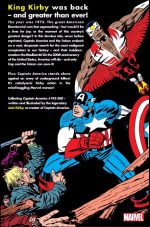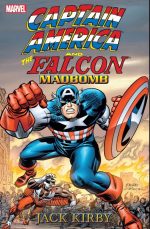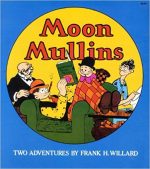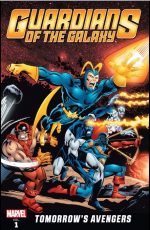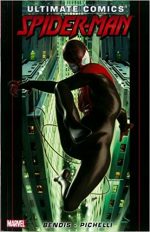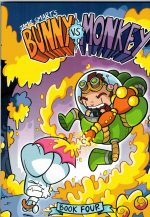
By Jamie Smart (David Fickling Books)
ISBN: 978-1-910989-79-1
Since its premiere in 2012, The Phoenix has offered humour, adventure, quizzes, puzzles and educational material in a traditional-seeming weekly comics anthology for girls and boys. The vibrant parade of cartoon fun and fantasy has won praise from the Great and the Good, child literacy experts and the only people who really count – a dedicated and growing legion of totally engaged kids and parents who read it avidly…
The publishers would be crazy not to gather their greatest serial hits into a line of fabulously engaging album compilations, but they’re not so they do. The latest of these is a fourth fabulous paperback-bound bout of ongoing conflict gripping a once-chummy woodland waif and interloping, grandeur-hungry hairy-brained simian…
Concocted with feverishly gleeful inspiration by Jamie Smart (Fish Head Steve!), Bunny vs. Monkey has been a Phoenix fixture from the first issue: recounting a madcap vendetta between animal arch-enemies set amidst an idyllic arcadia which masquerades as a more-or-less mundane English Wood.
Book Four boldly delves deep into the pasts of the uncanny assortment of odd critters littering and loitering around the bucolic paradise – and not before time – as the rapidly encroaching Hyoomanz are now well underway in building something called a motorway through the sylvan glades and apparently unprotected parks…
Sadly all the tail-biting tension does nothing to derail the ongoing but so-far localised war of wits and wonder-weapons which began when an obnoxious simian intruder popped up after a disastrous space shot went awry.
Having crash-landed in Crinkle Woods – a scant few miles from his blast-off site – Monkey believes himself the rightful owner of a strange new world, despite the continual efforts of reasonable, sensible, genteel, contemplative Bunny. For all his patience, propriety and good breeding, the laid-back lepine just cannot contain the incorrigible idiot ape, who is a rude, noise-loving, chaos-creating troublemaker…
These collected volumes dispense disaster-drenched doses of daftness in six-month courses of ill-treatment and this book describes Year Two: July-December after another vivid Contents page and character catch-ups and score-cards, plus a double-page spread pinup…
The already fraught atmosphere of the forest gets another unnecessary shot of adrenaline as ‘A New Challenger Appears’ in the fuzzy form of The Maniacal Badger, resolutely challenging resident reprobate Skunky (a brilliant inventor with a bombastic line in animal-themed atrocity-weapons and a secret agenda of his own) for the title of top mad scientist, after which Monkey wrecks a playground but loses face once Bunny gets him to share a ‘See-Saw!’…
Skunky horrifies blithering innocents Weenie Squirrel and Pig when his ‘Grav-O-Box’ sets the river running backwards but when co-conspirator Monkey ruins the test flight of his Hot Air Balloon Jet Engines and propels them ‘Around the Woods in 80 Seconds’ the malcontents themselves are the only ones to suffer…
Sinking into over-indulgence the simian stinker has to take drastic action after becoming a ‘Fat Monkey’ before stealing some building machinery from the Hyoomanz in ‘Monkey at Work’…
Skunky upsets the balance of nature – and value of custard – after creating aberrant lifeform ‘The Wobbles!’ before every animal pulls together when a Hyooman wanders in and Bunny orders ‘Battle Stations’. Skunky then stupidly makes things so much worse by splicing Science to Nature and releasing ‘The Vines’…
An annoying game of ‘Poink!’ drives everybody bonkers but welcome terror returns after the colossal ‘Monkeytron!’ rampages through the trees, just in time to greet rocket scientists searching for a test monkey they lost in the very first episode…
Pig’s origin is revealed in the cleverly obfuscatory (not!) ‘A Pig on the Range’ after which Park Ranger Derek P. Brigstocke has a close encounter with a net and ‘A Bear Bum!’ and irrepressible yet lonely cyber-crocodile ‘The Incredible Metal Steve’ undergoes a ferocious metal-morphosis even as ‘Bunny Vs. Monkey!’ finds our notional stars getting back to bruising basics in their never-ending struggle…
After a troop of Hyooman cub scouts fail to ‘Catch That Bunny’ Pig and Squirrel dig up ‘Worms’ and take the slimy earth-movers fishing, but not in any way you’ve seen before, whilst ‘Goodbye, Bunny’ finds our pacifist protagonist plunging deep into the distant city in search of his origins even as Pig becomes a dragon-slaying knight in ‘Arise, Lord Wuffywuff!’
…And none too soon as it happens, since with snow falling the Maniacal Badger returns to worry the woodland folk with ‘The Thing!’ he’d stolen from the Hyoomanz Building Site, prompting a desperate search for natural leader Bunny: a trail that takes them to a comfortable suburban hutch and ‘A Place Where You Belong’…
Reunited with the Crinkle Woods critters, Bunny finds a time machine and – by accidentally visiting ‘Once Upon a Time’ – discovers the true secret of Skunky’s vast and evil intellect in an extra-long extravaganza which segues straight into the formation of sadly deficient superhero team the Rather Good Squad in ‘Choose Your Side!’
With Christmas fast approaching, festivities are briefly disrupted by marauding ‘Snow Meanies’ before the Builders try secretly bulldozing the Woods only to be stopped by Monkey, gleefully brain-battered, bewildered former stuntman Action Beaver and ‘The Real Santa!’…
The madcap mayhem concludes with a portentous epilogue as ‘Door B’ opens to reveal the ultimate triumph of the ultimate villainous mastermind, but that’s…
To Be Continued
The absolute acme of absurdist adventure, Bunny Vs Monkey is well on the way to becoming a British Institution of weird wit, brilliant invention and superb cartooning: an utterly irresistible joy for grown-ups of every vintage, even those who claim they only get it for their kids…
Text and illustrations © Jamie Smart 2017. All rights reserved.
Bunny Vs Monkey Book Three will be released on 6th July 2017 and is available for pre-order now.

